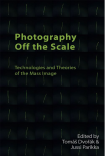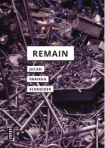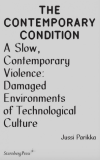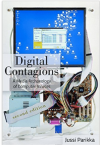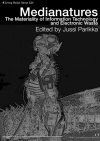Archive
First signs
First signs of Operational Images existing as a printed book.

Japanese translation of A Geology of Media
I am happy to see this out: the Japanese edition of A Geology of Media. A big thanks to Yoshitaka Ota and the publisher for their work in making this happen. See here for more info – and if you do not read Japanese, check out at least the gorgeous cover design (that features a detail from Danish artist Honey Biba Beckerlee’s work). For the first brief review of the book in Japanese, see here.

Forthcoming in 2023: Operational Images
First signs of my forthcoming book Operational Images: From the Visual to the Invisual are online. Featured in the University of Minnesota Press new Spring /Summer 2023 catalogue.

An in-depth look into the transformation of visual culture and digital aesthetics
First introduced by the German filmmaker Harun Farocki, the term operational images defines the expanding field of machine vision. In this study, media theorist Jussi Parikka develops Farocki’s initial concept by considering the extent to which operational images have pervaded today’s visual culture, outlining how data technologies continue to develop and disrupt our understanding of images beyond representation.
Charting the ways that operational images have been employed throughout a variety of f ields and historical epochs, Parikka details their many roles as technologies of analysis, capture, measurement, diagramming, laboring, (machine) learning, identification, tracking, and destruction. He demonstrates how, though inextricable from issues of power and control, operational images extend their reach far beyond militaristic and colonial violence and into the realms of artificial intelligence, data, and numerous aspects of art, media, and everyday visual culture.
Serving as an extensive guide to a key concept in contemporary art, design, and media theory, Operational Images explores the implications of machine vision and the limits of human agency. Through a wealth of case studies highlighting the areas where imagery and data intersect, this book gives unprecedented insight into the ever-evolving world of posthuman visuality.
See here for the preface to the book.
The cover image includes a detail from Maria Constanza Ferreira’s video work.
New Czech titles
Now published in Czech, two closely connected books: the translation of What is Media Archaeology? (transl. Michal Šimůnek) and Martin Charvát’s book about my work Jussi Parikka: Od archeologie ke geologii médií (“Jussi Parikka: From Media Archaeology to Geology of Media”). Very excited and grateful to both of them for their work, insights, and careful attention.

The publisher is NAMU press.
Below a short glimpse of the interview we did with Martin for his book (note that the original English discussion has not been tidied so please excuse any minor language hiccups).
<M. C. As I see it, in your work there is a strong tendency present: from the analysis of „dark sides“ of digital culture to geology of media, to the (on the one hand) abstract but strictly material frameworks (or empirical conditions of possibilities) of contemporary digital culture based on using (in a sense of dependency) material from Earth, and to the (on the other hand) urgent need to look at these phenomena through (to put it in Deleuzean terms) “geology of morals”, which transcends a priori critique of technique, and thematizes the usage or cultural techniques emerging in contemporary society and connect them with geo-political climate.
J. P. I was originally trained in Cultural History (in Turku, Finland) which was great background education to consider the broader historical contexts of contemporary culture. It was also a context where I had to do extra work in figuring out how I can continue my theoretical interests while engaging in historical methods. One line of thought that cuts across those themes, those tendencies, is that I am interested in the anomalous, whether that is in relation to the dark sides and accidents of technological culture or in terms of the alternative methodological and conceptual angles that unfold a different perspective. The Deleuzean impact was early on really important for me – I still remember well the course on Deleuze (and a bit on Guattari) that professor Jukka Sihvonen gave in Turku and that I attended together with my friend, media scholar Pasi Väliaho. It was an eye-opener. I did not know how to place it exactly in terms of my other studies but it crept into some work I did in Finnish (including a book that was published in Finnish, Koneoppi) and then to some themes in Digital Contagions that was also my doctoral project that later turned into a book. Another influence was Friedrich Kittler, also introduced by Sihvonen, and whose work then became a different way of trying to start thinking questions of materiality which led into discussions also in new materialism from a much more material feminist position. Rosi Braidotti’s seminars in 2005 were another eye opener.
But in terms of the theme of the anomalous – it does not necessarily mean even marginal. Just that from Digital Contagions to later work, I was trying to come up with questions that are not necessarily at first obvious; conceptual twists that offer different perspectives while building on existing theoretical and scholarly traditions, but also rhetorically are able to frame a different way of understanding those conceptual entities inside “media studies” but also way outside it.
The geopolitical that includes Earth energies is far from marginal but I felt a necessary way to continue the link between conceptual work, extended media studies perspectives, and burning contemporary topics. I was trying to avoid it being merely a contribution to the Anthropocene debate about this new geological period defined by industrialism, synthetic chemistry and massive scale of agriculture, the nuclear age and mass exterminations of multiple kinds – including as many have pointed out, colonial time scales – and think of ways how the question of materiality can be placed in questions of ecology. Geology of morals turns into a Robert Smithson inspired large-scale, landscape-scale changes impacted by media and technological culture that also challenges models of agency and definitely forces non-anthropocentric perspectives both in analysis and in coming up with ethical solutions. To riff with Braidotti’s ideas: it was the ideal of the human in the modern Western humanism that got us into a lot of trouble with its colonial human (able-male) centric ways of organizing worldviews; now we are in the midst of a larger transformation where other questions have to be brought forward for a more radical sustainable future.
[…]
M. C. Currently you are the head of GAČR EXPRO project at Prague Famu. Could you elaborate please a little bit about the topic of the research? (Operational images)
J. P. Operational images is a concept that stems from the filmmaker Harun Farocki’s work and investigations. Already in his work in the 1980s and 1990s he mapped visual forms of measurement and rationalization of the world in relation to political history, violence, holocaust, and industrial scale violence although the concept emerges in a more articulated form in the Eye/Machine video series of installations between 2000-2003. While Farocki’s work is interesting as such – in how it articulates themes of proximity/distance, visuality/calculation, war/media – our project picks up on the concept itself: operational images as images that function primarily as part of a (technical) operation like in the case of self-guided missile systems, machine vision systems, robotics, etc. The concept has had a vivid afterlife following Farocki and it pops up in use by theorists and artists such as Hito Steyerl and Trevor Paglen, as well as in works by many of the colleagues in media studies etc., but we are interested both in how to use it as a concept to outline alternative histories of photography and visual culture and to open up new questions in contemporary contexts of art and visual theory.
For example, I am working with Abelardo Gil-Fournier on outlining questions of vegetal materiality and visual culture, from late 19th century plant physiology and framing of photosynthesis to broader scales such as in Vladimir Vernadsky’s take on the planetary biosphere. We are interested in how from questions of photography and visual culture we can outline a take on operational images in scientific contexts, planetary scales of plants and agriculture, and this refurbishing of the planet by way of terraforming that has taken place for example indeed in agriculture.
Of course the project incorporates more than that. Tomas Dvorak’s investigations into photography as measurement is one insightful way of dealing with the overlap between methods in history of science and media; previously, our conference theme was on Expert-Readable Images expanding the idea of machinic agency of images (Machine-Readable) to the work of experts and specialist practices too. Also our book Photography off the Scale that came out in 2021 with Edinburgh University Press included contributions from our project team on the question of measure, scale, and quantity in photographic culture.
The book Operational Images. From the Visual to the Invisual is forthcoming from University of Minnesota Press in 2023.
The Lab Book is out!
I am very happy that our co-authored The Lab Book: Situated Practices in Media Studies is out. Written with Lori Emerson and Darren Wershler, the book stems from research that started around 2015 and investigates the changing status of the lab as it features especially outside the fields of science and engineering. The mushrooming of labs of all sorts – and not all only academic, as many coffee labs, brew labs, and hair labs testify – has resulted in a situation we refer to as the hybrid lab. The many aspects that make up the hybrid lab are captured in this diagram on the extended lab, a model that also guides our book’s chapters

We are also grateful for the several dialogues, interviews, and other help that several people affiliated directly or indirectly with labs provided. We were able to test our ideas and get really important feedback from so many different lab setups that also showed the many scales of labs. Some of the interviews are available on University of Minnesota Press’ Manifold platform.
Do get in touch with any queries, review copy requests, or alike.

“Lively, timely, and filled with vivid examples, The Lab Book is a highly readable and critically sophisticated account of current lab culture. Written by three distinguished practitioners, it examines the rhetoric that links real and imaginary ideas of experimentality with systems of power and authority across a surprising range of disciplines. A fun, smart, useful guide to ongoing work in media studies.”
— Johanna Drucker, author of Visualization and Interpretation: Humanistic Approaches to Display
“The Lab Book makes an extremely important contribution to contemporary discourse about the production of knowledge. In many ways, it is the most important book on the topic since the laboratory studies of Bruno Latour in its potential reach across disciplines and methodologies. Its careful close reading of images and quoted material is particularly compelling, and the writing style is accessible and clear, even while explaining somewhat arcane topics in science studies around infrastructures, apparatuses, ideologies, and assemblages.”
— Elizabeth Losh, author of Hashtag
Sensoria by McKenzie Wark
McKenzie Wark’s new book Sensoria: Thinkers for the Twenty-first Century is out and I am chuffed (as the British say) to be included in the fabulous lineup of theorists and writers that she rolls out in this follow-up of the General Intellects volume.
“As we face the compounded crises of late capitalism, environmental catastrophe and technological transformation, who are the thinkers and the ideas who will allow us to understand the world we live in? McKenzie Wark surveys three areas at the cutting edge of current critical thinking: media ecologies, post-colonial ethnographies, and the design of technology, and introduces us to the thinking of seventeen major writers who, combined, contribute to the common task of knowing the world. Each chapter is a concise account of an individual thinker, providing useful context and connections to the work of the others.
The authors include: Sianne Ngai, Kodwo Eshun, Lisa Nakamura, Hito Steyerl, Yves Citton, Randy Martin, Jackie Wang, Wang Hui, Anna Lowenhaupt Tsing, Achille Mbembe, Eyal Weizman, Cory Doctorow, Benjamin Bratton, Tiziana Terranova, Keller Easterling, Jussi Parikka, Deborah Danowich and Eduardo Viveiros de Castro
Wark argues that we are too often told that expertise is obtained by specialisation. Sensoria connects the themes and arguments across intellectual silos. The book is a vital and timely introduction to the future both as a warning but also as a roadmap for how we might find our way out of the current crisis.”
Oberhausen interview
Here’s a new video interview, done for the Oberhausen film festival. Click below the image to get to the video where we discuss viruses, digital culture, masks, and more. The book Digital Contagions is one starting point but we end up in many other areas too.
To Media Study
I was invited to contribute a short text for the inaugural issue of the new journal MAST – The Journal of Media Art Study and Theory. The whole issue is a great compilation of interesting and insightful texts that you can access as direct PDF here.
My text was a brief take on media studies – both media studies as a discipline and media study as an activity. Here’s the beginning of the text that can be accessed through the PDF link above.
To Media Study: Media Studies and Beyond
To study media is to study more than what we already recognize as media. The beauty of media study should involve the possibility of methodological and theoretical labor that investigates what even constitutes its object of knowledge and the process through which such objects of knowledge are stabilised as the thing that circulates as “media” in academia. It even includes the possibility of considering academia as an institution and its practices as “media,” a proposition made by Friedrich Kittler (2004). Indeed, universities consist of a changing set of practices and techniques programmed into students and future staff, hardware from libraries to mail systems and objects of knowledge that provide one operating system for a range of contemporary operations—mathematics to philosophy as well as computing. Not that we need to accept all the details and specifics of the story (and its European bias, as Kittler also stated) but the methodology of realising that media relates not to “communication,” but to material architectures, cultural techniques, and infrastructures from hardware to standards is the key takeaway. In short, even the academic study itself is, well, media.
To study media is to study what then even becomes media in the first place, and how mediation is much more than what counts as media as such. Hence, media study and its stabilized version in academia, Media Studies, can be in a privileged position to understand how the question of media shifts from the human scale of interface to large-scale networks, infrastructure, and logistics. Some of the greyest things are the most exciting when it comes to understanding the powers of media: administration, logistics, infrastructural arrangement and territorial governance. Media is placed in actual spatial, material, and institutional realities.
Not that the academia is the sole place of media study – media study also happens outside Media Studies. Indeed, to radicalize Kittler’s point about media at the university, we need to recognise the subtle – and sometimes not so subtle – mechanisms of economic power that enable and disable the possibilities of study. To study media is also to recognise, as Stefano Harney and Fred Moten (2013) importantly argue, that it happens in contemporary contexts of debt and governance that are, one might add, part of the “media” and cultural techniques of the university and of how it produces experience and habit. To study should not be about the reproduction of misery as part of the policy of the current academic institutional landscapes, or as Moten puts it: “I think that a huge part of it has to do simply with, let’s call it, a certain reduction of intellectual life – to reduce study into critique, and then at the same time, a really, really horrific, brutal reduction of critique to debunking, which operates under the general assumption that naturalised academic misery loves company in its isolation, like some kind of warped communal alienation in which people are tied together not by blood or a common language but by the bad feeling they compete over.” (Harney and Moten 120).
[…continues: here. PDF]
Virality and Digital Contagions
The publisher of my book Digital Contagions: A Media Archaeology of Computer Viruses (2nd updated edition, 2016) has given free access to the preface by Sean Cubitt and my Introduction to the book. The download can be accessed on the publisher’s website.
From Sean Cubitt’s opening words:
“There is a disturbing etymological puzzle underlying the title. “Contagion” appears to be a late fourteenth-century coinage, appearing in the wake of the Black Death in mediaeval French and Middle English, from the Latin roots “con,” meaning “with,” and “tangere,” the active verb “to touch.” The puzzle comes from another word we associate at least equally closely with electronic media, “contact.” Here the root words are the same, with the only exception that “contact” comes from the passive form “tactum,” “to be touched.” Oddly, most people probably feel positive connotations about “contact,” but negative connotations from “contagion.” We have had six hundred years to develop these connotations, and yet there remains a nub of their origins: the contagious principle of something coming to touch us or to touch us together is more subjective than the principle of contact, where any two things could be brought together. The usefulness of the electrical contact as a major metaphor, dating back through early electrical experiments and familiar from the literature of the pioneering days of motoring and aviation, gives it both a certain objectivity and a sense of familiarity that we bring into the realm of communicative contact. Not so contagion, even though it is very close, at least etymologically.”
In this context, it might be also relevant to mention the piece the French publication AOC commissioned us with Tony Sampson to write on different models of virality and media.
Here’s the link to the French version.
And Boundary 2 Online published the English version: The New Logics of Viral Media.
Geologie médií
The Czech translation of A Geology of Media is now out and available with Karolinum publishing house (Prague) as Geologie médií. Also the Czech translation of What is Media Archaeology? is forthcoming (probably 2021) as well as a book focusing on my work (planned to be out in 2021).




